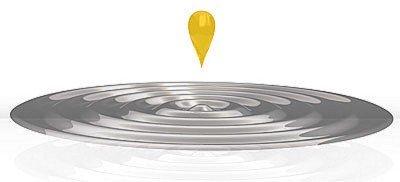Af Arne Rodahl
Gåsehudsfaktoren er noget der tales om i high-end-klassen, hvilket betyder at musikken kryber ind under huden og får hårene til at rejse sig.
Meget skal gå op i en højere enhed, ikke mindst er stereoperspektivet er en vigtig faktor som bevirker, at man kan plukke hvor hvert enkelt instrument er placeret.
Med en vokalist som står præcis i midten i stedet for at være malet bredt ud over et diffust lydlandskap. Og hvor man kan høre en enkel violinist blandt et stort strygeorkester. En i orkesteret finder selvsagt på at hoste i løbet af koncerten, midt i det mest stille parti. Var det fløjtenisten på fjerde række? Eller klarinettisten på femte?
Punktkilde
Et optimalt stereoperspektiv er kun muligt når lyden fra højttalerens diskantelement træffer øret præcist samtidig med mellemtoneelementet. Foruden det faktum at delefilteret i udgangspunktet må være superpræcist.
Man kan løse det ved at placere højttalerne med en lang afstand til lytteren, så de to elementene blir en tilnærmet punktkilde. Nogle producenter vinkler kabinettene noget, så diskanten er vinklet ned, mens mellomteneelementet spiller ret frem, og de dermed mødes optimalt i sweetspot.
Koaksialhøjttaleren er den ægte punktkilde
Det findes en anden måde at gøre det på, nemlig ved at placere diskantelementet midt i mellemtoneelementet og forene de to til et koaksialelement. Dette fungerer som en ægte punktkilde, uanset afstand og vinkel mellem højttaleren og lytteren. Det bevirker, at man får en bred sweet-spot, hvor man kan nyde et præcist stereoperspektiv næsten uanset hvordan man placerer sig i forhold til højttalerne. Dette åbner for interessante muligheder, som kan anvendes i en højttaler som nærfelts monitor, fordi det ikke spiller nogen rolle hvor tæt på højttalerne man sidder, når man arbejder med lyd.
Siden1985 har jeg research`et i anvendelsen af coaxialdrivere.
Udviklingen af Concenti Prisma reolhøjttaler med VIFA og Monacor coaxial-drivere.
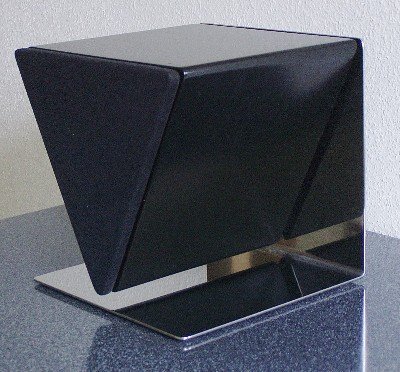
Prototype Concenti Prisma anno 1990 med coxial-driver
Concenti projektet havde formålet, at anvende coaxial-drivere til gengivelse af en uniform lydspredning og tillige give stereobilledet gode konditioner for en tredimensional punktformighed.
Projektet blev lagt midlertidig på hylden, idet der på den tid ikke fandtes coaxial-drivere med acceptale egenskaber.
Research´en havde dog overbevist mig om, at brugen af coaxial-drivere gav nogle fordele sammenlignet med konventionelle fler-vejs systemer. Fordele som følge af en fuldstændig homogen lydspredning i alle retninger samt en præcis tredimensional punktformighed af musikinstrumenters placering i lydbilledet.
SEAS´s og KEF´s patenterede coaxialsystem
I 1989 startede på samme tid SEAS og KEF udviklingen af nye coaxial-drivere baseret på en præcis og optimal placering af diskantelementet, - der hvor driverens polstykke munder ud i mellemtone-membranes centrum. En konstruktion der er kompliceret at udføre og som kun SEAS og KEF mestrer. Konstruktion er tillige patenteret, så ingen andre producenter har den på deres program.
Muligheden blev tilvejebragt ved fremkomsten og brugen af kompakte diskantdrivere baseret på de meget kraftige og små neodymium-magneter.
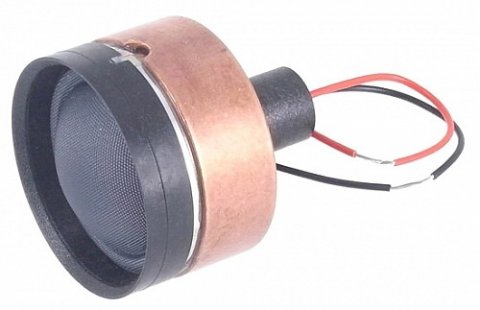
Diskant elementet i SEAS coaxial-driveren
Ved at flytte magnetsystem og samtidig forlænge svingspolerøret bliver der plads til diskantelementet, der herved kan anbringes præcist i mellemtonemembranens center uden reflekterende kanter.
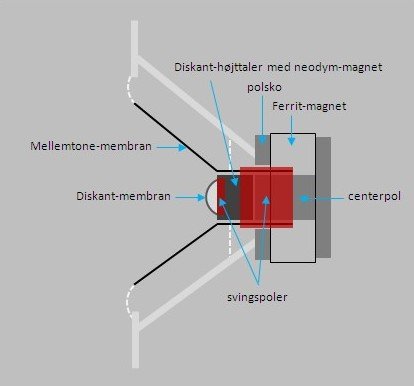
Skematisk snit af SEAS coaxial-driver.
Baseret på den nye teknik er coaxial- terminologien blevet aktuel bl.a. til monitorer i studier og betegnes i nutidens fagsprog for ”Point Source”.
Desuden ses en spirende tendens til high-end højttalersystemer i prisklasser op til ½ million anvende coaxial-drivere til mellemtone- og højttoneområdet for netop at opnå en uniform spredning og en præcis punktformighed.
_____________________________
Besøg hos SEAS
I foråret 2012 besøgte Akademiet SEAS fabrikken i Norge.
Vi blev vel modtaget af Olav Mellum Arntzen (Managing Director) og over en kop kaffe fik vi en overordnet indsigt i SEAS`s tanker omkring den fremtidige udvikling og brug af coaxial-drivere.
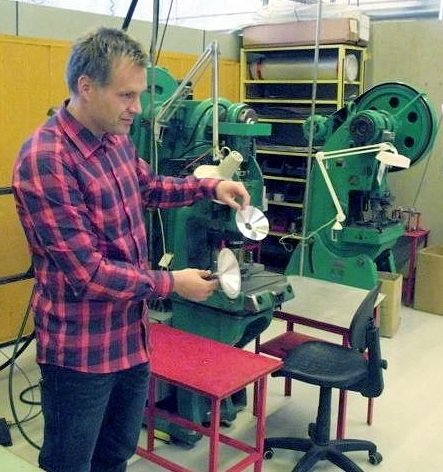
Olav fremviser magnesiummembraner til videre forarbejdning.
Vi fik en rundvisning på fabrikken og jeg fornemmede en god stemning både blandt de ansatte og de fysiske rammer. En stemning der helt sikkert afspejler sig i det færdige produkts gennemførte kvalitet. Således håndlaves væsentlige faser i produktionen, ligesom hver enkelt driver sluttestes.
Vi var også et smut i udviklingsafdelingen, hvor det meste er tys tys. Afdelingen ledes af Håvard Sollien (R&D).
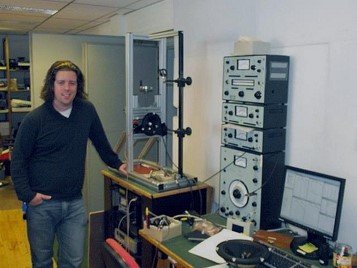
.... og således startede et samarbejde med SEAS.
______________________________
Udvikling af SAT 1 kompakthøjttaleren
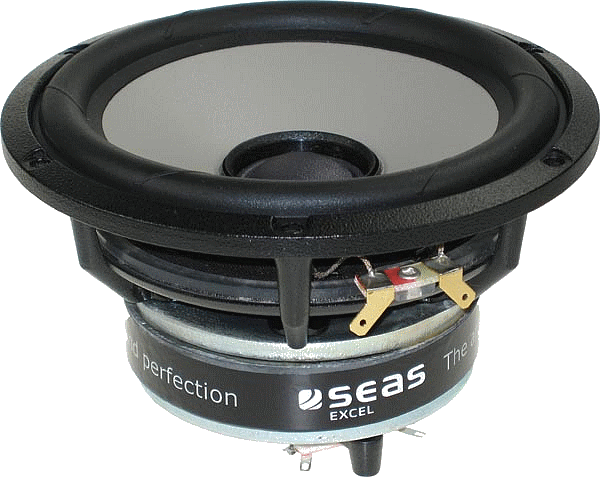
16 cm coaxial-element
High-end two-way coaxial driver system
Point Source System
Accurate 3D sound-reproduction
Homogeneous sound-dissipation and lobing-free in all directions
Magnesium Cone, brak-ups-free
Extremly low coloring of sound-reproduction
Simple manufacture-procedure
Compact closed enclosure
Only one hole for the driver
No Reflexport
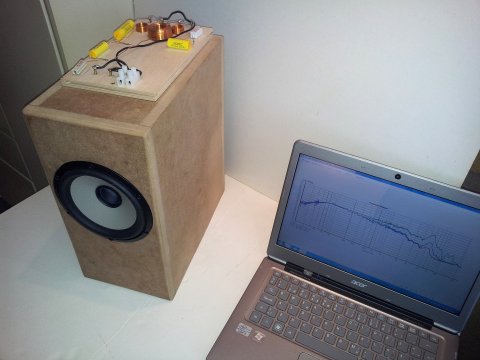
SAT 1 er LAB-modellen med ekstern eksperimental delefilter.Måling af kabinet-vibrationer.
Et simuleret trykkammersystem på 10 liter gav de optimale arbejdsbetingelse til projektets formål og relateret til driverens Thiele/ Small parametre.
SEAS`s basis-filter blev som udgangspunkt anvendt til de første målinger og lyttetest, men blev efterfølgende væsentlig modificeret. Dog blev det asymmetriske filter bibeholdt med 6 dB / 18 dB samt notch filter til dæmpning af den uundgåelige ringning i magnesiummembranen ved ca. 5 kHz.
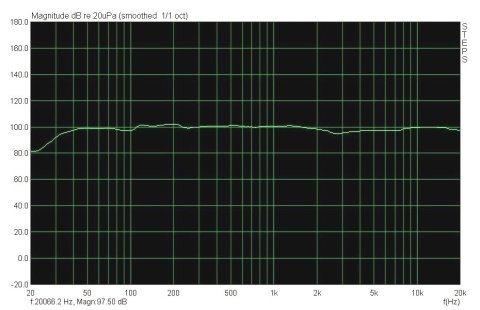
Frekvensrespons Steps, 1 meter / On axis
______________________________
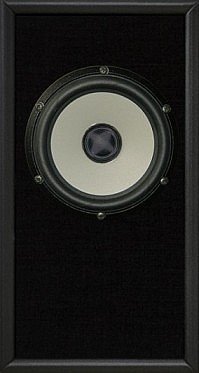
SAT 1 - Frislev custom
Point Source System (To-way / crossover 2,5 kHz)
Driver : SEAS 146 mm Coaxial / EAD filter network
Magnesium cone, bass / midrange
Fabric cone, high frequence
Faraday rings reduce non linear and modulation distortion
Box Type : 10 Litre, closed, progressive dampmaterial
Nominal Impedance : 4 Ohms
Short Term Power Handling* : 220 Watt
Long Term Power Handling* : 80 Watt (100watt with 80 Hz High Pass filter)
Sensitivity 2,83V / 1m : 84 dB
Frequence-response +/- 3dB : 30 – 25.000 (close to wall )
Use : Stereo, center and surround, Furniture customised
* IEC 268-5
__________________________________________________________________________
Ny SEAS coax
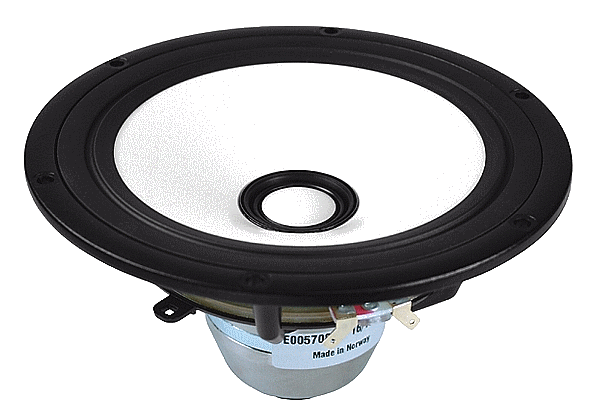
__________________________________________________________________________
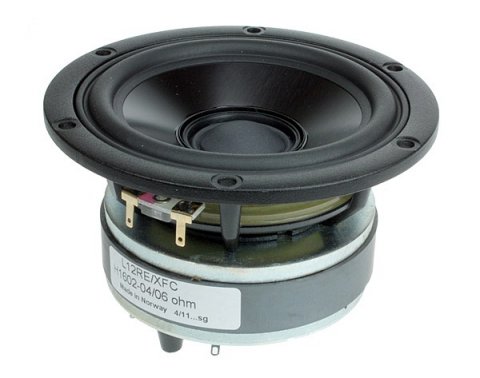
L12RE/XFC
The L12RE/XFC is a coaxial loudspeaker providing high quality sound in a very compact format.
The coaxially arranged precoated fabric dome high frequency unit has a low resonance frequency, and integrates with the cone driver to a point source. Voice coil windings immersed in magnetic fluid increase short term power handling capacity and reduce the compression at high power levels
The cone of the woofer acts as a moderate horn loading for the tweeter, and the chassis of the dome unit represents the throat of this horn.
The stiff, yet light aluminum cone acts as a piston throughout the recommended frequency range.
_________________________________________________________________________
Point Source Speakers are Better

The next time you see a duck (sat on a pond) take two or three pieces of bread and throw them in the pond so that they land close together and at the same time. Watch the ripples produced and how they spead out - you will see they are very confused - hard to follow. Wait for the water to settle, then throw in a single piece of bread (away from the duck!) and observe how uniformly the ripples spread out in a pure circle.
This is an EXACT analogy of how sound waves travel in air. A single (one-way speaker) produces a series of vibrations (ripples) that travel out from the speaker in a coherent (all together) fashion. The result : beautiful clear, direct sound with no confusion. Multiple speakers (2 or more) produce vibrations exactly like the confused ripples you saw when throwing multiple objects into the pond and produce lots of incoherent (confused) vibrations.
This is complicated by the fact that as you change position (even slightly) in front of a multiple speaker, you hear different combinations of ripples (vibrations) that affect your perception of the sound - you lose focus.
Given the pond illustration, a single speaker must have the edge when it comes to producing a focused, coherent sound front and this is true. The difficulty is that no single driver can reproduce the full range of sounds contained within the audio spectrum and we need both a woofer and tweeter to achieve this. The point source problem is solved very cleverly by mounting the tweeter at the center and on the same exact axis as, the woofer.
The Coaxial two-way speaker can and does produce the same clearly focused pattern as a single speaker, but crucialy, now across the whole audio spectrum.
Hence we get the best of both worlds.
KEF Uni-Q / Coaxial Driver

It is not easy to produce a convincing and realistic illusion of a live performance because the sound from a high quality loudspeaker does not come from a single source, or drive unit. Two or more units are required to faithfully reproduce the entire audio spectrum from the low bass produced by a concert organ or a cinema explosion, to the delicate nuances of the human voice in the midrange right up to the shimmering treble of cymbals. Most loudspeakers have the midrange and treble drive units mounted one above the other, so the sound is coming from two different places, causing audio ‘confusion’ and losing the chance of achieving a truly natural sound. With Uni-Q coaxial driver, the midrange and treble units are mounted at precisely the same point in space – allowing them to integrate perfectly and create the ideal sound field for the listener to experience a convincingly natural sound.
It has been well known for many years in the audio industry that one of the ideal forms for a loudspeaker is the ‘point source’- where all the sound is radiated from the same point in space. To do this, the drive units (for example, the bass and treble units in a two-way system) need to be mounted so that their acoustic centres are at the same place. The problem in achieving this was the sheer physical size of the treble unit, which prevented it from fitting in the centre of the bass unit. Various forms of coaxial units emerged where the tweeter was mounted either in front of or behind the acoustic centre of the bass unit but these have significant drawbacks. The key to the invention of Uni-Q was the arrival on the market of a new magnetic material called Neodymium-Iron-Boron, which has ten times the magnetic strength of a conventional ferrite magnet. This material allowed a high sensitivity treble unit to be made small enough to fit within the voice coil diameter of a typical bass unit and so be placed at the precise point where the acoustic sources are ‘coincident’.
With the acoustic centres at the same point in space the acoustic outputs of the bass and treble units are ‘time-aligned’ in all directions allowing the designer to achieve perfect integration between the units not just on one axis, as is the situation with vertically separated units, but in all directions. The first advantage of Uni-Q, therefore, is the lack of the vertical interference pattern of separated bass and treble units, which restricts the region of high quality sound output to only +/- 10 degrees above and below the principle axis. This same effect not only limits the vertical listening area but also produces a dip in the total energy output in the bass/treble crossover region, causing a distortion of the reverberant energy in the listening room. In Uni-Q systems this effect is completely eliminated.

Vertical Dispersion
The second advantage of Uni-Q is what we call ‘matched directivity’. With the treble unit mounted at the centre of the bass driver’s cone, its directivity (the spread of sound away from the main axis) is governed by the angle of the cone, which also largely determines the directivity of the bass driver. So with the coincident mounting of the two units, the directivity of the treble unit is adjusted to be virtually the same as that of the bass driver. As a listener moves away from the main axis, the output of the treble unit falls off at approximately the same rate as that of the bass unit, thus improving the uniformity of tonal balance across the listening area, and improving the off-axis stereo imaging. The listener is not, therefore, as limited to a central ‘sweet-spot’ as with conventional speakers. And, of course, the same is also happening in the vertical plane, so the reverberant energy in the listening room maintains an even balance, adding realistic ambience to the sound without introducing tonal colorations. The directivity is often referred to in engineering terms as the ‘Q’, and the ‘Unifying’ of the ‘Q’ gives rise to the name ‘Uni-Q.
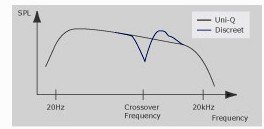
RePower Response of Uni-Q and Discrete Systems
Discrete systems have a dip in the power response (total energy output) at the crossover frequency due to the interference (or 'lobing') between the LF and HF units and a peak above the crossover frequency due to the non-matched directivities of the LF and HF units. Coaxial-Systems have a smoother power response which leads to a well balanced and natural sounding reverberant field in the listening room.
From a listener’s perspective, the combination of the matched directivity and precise time alignment in all directions gives significantly improved stereo imaging over a wide listening area, the realism of which is enhanced by the even balance of the reverberant energy within the listening room.
__________________________________
Den ideelle lydgengivelse til TV´et


Hifiakademiets SAT 1 højttaler skræddersyet til Frislev reol
Anvendelse af Frislevs skræddersyede reol som TV-hylde med modul til indbygning af højttalere, synes som en ideeil løsning såvel møbelmæssigt som lydmæssigt .
SAT 1 højttaleren er skræddersyet til indbygning i Frislev reolen, hvilket betyder, at højttalerdimensionerne matcher komplet til reolen. Herved undgåes lydrefleksioner fra omkringliggende kanter.
SAT 1´ s koaxialsystem sikrer en lydspredning, der er 100% homogen uanset lytteposition. En fordel når flere skal se TV.
Koaxialsystemet er som beskrevet i artiklen uovertruffet med hensyn til punktkilde gengivelse, - et must til både musikgengivelse og lyden på film.
